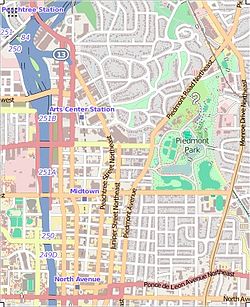The Temple (Atlanta)
 From Wikipedia - Reading time: 17 min
From Wikipedia - Reading time: 17 min
| The Temple | |
|---|---|
 | |
| Religion | |
| Affiliation | Reform Judaism |
| Ecclesiastical or organisational status | Synagogue |
| Ownership | Hebrew Benevolent Congregation |
| Leadership |
|
| Status | Active |
| Location | |
| Location | 1589 Peachtree Street NE, Atlanta, Georgia 30309 |
| Country | United States |
| Geographic coordinates | 33°47′52″N 84°23′21″W / 33.79778°N 84.38917°W |
| Architecture | |
| Architect(s) | Philip Shutze |
| Type | Synagogue |
| Style | Neoclassical |
| General contractor | Mr. Birchey |
| Date established | 1860 (as a congregation) |
| Completed |
|
| Dome(s) | One |
| Website | |
| the-temple | |
The Temple | |
| NRHP reference No. | 82002420 |
| Significant dates | |
| Added to NRHP | September 9, 1982 |
| Designated ALB | October 23, 1989 |
| [1][2][3] | |
The Temple (formally, the Hebrew Benevolent Congregation) is a Reform Jewish congregation and synagogue located at 1589 Peachtree Street NE, in Atlanta, Georgia, in the United States. The oldest Jewish congregation in Atlanta, it was established in 1860 to serve the needs of German-Jewish immigrants. The Temple, designed by Philip Trammell Shutze in a Neoclassical style, was completed in 1931.
The synagogue building was listed on the National Register of Historic Places on September 9, 1982;[3] and designated as an Atlanta Landmark Building on October 23, 1989.[2]
Architecture
[edit]The Neoclassical building has a pedimented portico, drum dome, and vaulted and domed sanctuary. Its rich finishing details include terrazzo floors, black marbleized-wood columns and gilded woodwork. Of particular significance is the intricate plaster relief work on the interior of the sanctuary's frieze, cornice, vaults and dome. In 1959 a three-story brick education building of contemporary design was added to the rear of the building.[3]
Organ
[edit]The Shutze temple opened in 1931 with a new Pilcher organ. In 1955, temple organist Emilie Spivey contracted Aeolian-Skinner to update and renovate the organ. The renovated organ, one of twelve in the country bearing G. Donald Harrison's signature plate, was dedicated October 14, 1955 with a performance of Ernest Bloch's Sacred Service. On Oct 30, 1955 Spivey played the opening recital of Mozart, Bloch, and Poulenc's organ concerto.[4][5] The organ underwent a major renovation in 2011-2012.[5]
History
[edit]Previous temples of the congregation were located at:[6]
- 1875–1902: Garnett and Forsyth Streets, downtown
- 1902–1929: South Pryor and Richardson Streets, Washington-Rawson neighborhood southeast of downtown[7]
During the 1950s and 1960s, The Temple became a center for civil rights advocacy. In response, white supremacists bombed The Temple on October 12, 1958, with no injuries. While arrests were made, there were no convictions. Atlanta Journal-Constitution editor Ralph McGill's outraged front-page column on the Temple bombing won a Pulitzer Prize for Editorial Writing.[8] The Temple and the bombing event was used as a central theme in the film Driving Miss Daisy (1989).
References
[edit]- ^ "National Register Information System". National Register of Historic Places. National Park Service. April 15, 2008.
- ^ a b "The Temple (Hebrew Benevolent Congregation)". Historic Preservation. City of Atlanta, GA. n.d. Retrieved January 11, 2024.
- ^ a b c Brooks, Caroline (September 9, 1982). "Nomination Form: The Temple". National Register of Historic Places. National Park Service. Retrieved January 11, 2024.
 This article incorporates text from this source, which is in the public domain.
This article incorporates text from this source, which is in the public domain.
- ^ "Organ in Atlanta Temple Opened by Emilie Spivey" (PDF). The Diapason. 47 (2): 1. January 1, 1956.
- ^ a b "The Organ - The Temple". www.the-temple.org. Retrieved October 25, 2022.
- ^ "Pioneer Citizens' History of Atlanta, 1833-1902: Pub. By the Pioneer Citizens' Society of Atlanta". 1902.
- ^ photo (Archived 4 March 2016 at the Wayback Machine) after it had been converted into a Greek Orthodox Church
- ^ "The Temple". Atlanta: A National Register of Historic Places Travel Itinerary. National Park Service. October 10, 2008. Archived from the original on August 17, 2007.
External links
[edit]- Official website
- The Temple at Atlanta Urban Design Commission
- Lockhart, James R. (August 1981). Images of The Temple (black and white). National Register of Historic Places. National Park Service. Retrieved January 11, 2024.
 KSF
KSF
